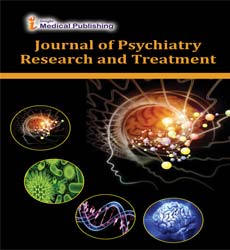Schizophrenia and Neuroinflammation: Emerging Insights into Pathophysiology and Treatment
Stephen Jorge*
Department of Pharmacology & Toxicology, University of Toronto, Toronto, ON, Canada
*Corresponding author:
Stephen Jorge,
Department of Pharmacology & Toxicology, University of Toronto, Toronto, ON, Canada;
Email: stephen@jorge.ca
Received date: January 01, 2025, Manuscript No. Ipprt-25-20618; Editor assigned date: January 03, 2025, PreQC No. Ipprt-25-20618(PQ); Reviewed date: January 15, 2025, QC No. Ipprt-25-20618; Revised date: January 22, 2025, Manuscript No. Ipprt-25-20618(R); Published date: January 28, 2025, DOI: 10.36648/ 2471-7975.7.1.05
Citation: Jorge S (2025) Schizophrenia and Neuroinflammation: Emerging Insights into Pathophysiology and Treatment. J Psychiatr Res Vol.07 No.1: 05
Introduction
Schizophrenia is a complex psychiatric disorder characterized by disturbances in thought, perception, and cognition, traditionally explained through dopaminergic and glutamatergic hypotheses. However, recent research has highlighted the critical role of neuroinflammation in its pathophysiology, linking immune system dysregulation, microglial activation, and pro-inflammatory cytokine signaling to altered brain function. This emerging paradigm suggests that schizophrenia may not solely be a neurotransmitter imbalance but a disorder with significant immunological underpinnings, opening avenues for novel diagnostic and therapeutic approaches [1].
Description
Neuroinflammation in schizophrenia has been increasingly supported by evidence of elevated pro-inflammatory cytokines such as interleukin-6, interleukin-1β, and tumor necrosis factor-α in the peripheral blood and cerebrospinal fluid of patients. Postmortem studies have shown activated microglia, the brainâ??s resident immune cells, which may contribute to synaptic pruning abnormalities, altered neuroplasticity, and white matter dysfunction. These immune disturbances are thought to interact with genetic susceptibility, prenatal infections, and environmental stressors, thereby increasing vulnerability to the disorder [2].
Importantly, inflammatory pathways may converge with classical neurotransmitter systems, explaining clinical heterogeneity and treatment resistance. Beyond pathophysiology, neuroinflammatory markers are being explored as potential biomarkers for diagnosis, prognosis, and treatment monitoring For example, C-Reactive Protein (CRP) and cytokine profiles have been correlated with symptom severity and cognitive decline in schizophrenia highlighting [3].
Their utility in precision medicine approaches. Neuroimaging studies using Positron Emission Tomography (PET) tracers to detect microglial activation further support the role of inflammation in disease progression. Such tools not only enhance understanding of underlying mechanisms but also provide potential for early identification of at-risk individuals and stratification of patients based on inflammatory status. Therapeutically, targeting neuroinflammation has opened new horizons in schizophrenia treatment [4].
Anti-inflammatory agents such as Non-Steroidal Anti-Inflammatory Drugs (NSAIDs), minocycline, and omega-3 fatty acids have shown modest benefits as adjunctive therapies, particularly in alleviating negative symptoms and cognitive deficits. More advanced strategies, including monoclonal antibodies against pro-inflammatory cytokines and immune-modulatory agents, are under clinical investigation [5].
Conclusion
The recognition of neuroinflammation as a key contributor to schizophrenia pathophysiology marks a significant advancement in psychiatric research. By bridging immune dysregulation with neural dysfunction, this perspective expands our understanding beyond neurotransmitter models and underscores the potential for immunomodulatory therapies. Continued research into inflammatory biomarkers and targeted treatments holds promise for more personalized, effective, and holistic management of schizophrenia, offering hope for better outcomes in this challenging disorder.
Acknowledgment
None.
Conflict of Interest
None.
References
- Pärtty A, Kalliomäki M, Wacklin P, Salminen S, Isolauri E (2015) A possible link between early probiotic intervention and the risk of neuropsychiatric disorders later in childhood: A randomized trial. Pediatr Res 77: 823–828
Google Scholar Cross Ref Indexed at
- Lüddecke R, Felnhofer A (2022) Virtual reality biofeedback in health: A scoping review. Appl Psychophysiol Biofeedback 47: 1–15
Google Scholar Cross Ref Indexed at
- Rudschies C, Schneider I (2024) Ethical, legal, and social implications (ELSI) of virtual agents and virtual reality in healthcare. Soc Sci Med 340: 116483
Google Scholar Cross Ref Indexed at
- Li M, Yu P, Shen Y (2025) A spatial and temporal transformer-based EEG emotion recognition in VR environment. Front Hum Neurosci 19: 1517273
Google Scholar Cross Ref Indexed at
- Alharbi H (2024) Explainable feature selection and deep learning based emotion recognition in virtual reality using eye tracker and physiological data. Front Med 11: 1438720
Google Scholar Cross Ref Indexed at
Open Access Journals
- Aquaculture & Veterinary Science
- Chemistry & Chemical Sciences
- Clinical Sciences
- Engineering
- General Science
- Genetics & Molecular Biology
- Health Care & Nursing
- Immunology & Microbiology
- Materials Science
- Mathematics & Physics
- Medical Sciences
- Neurology & Psychiatry
- Oncology & Cancer Science
- Pharmaceutical Sciences
